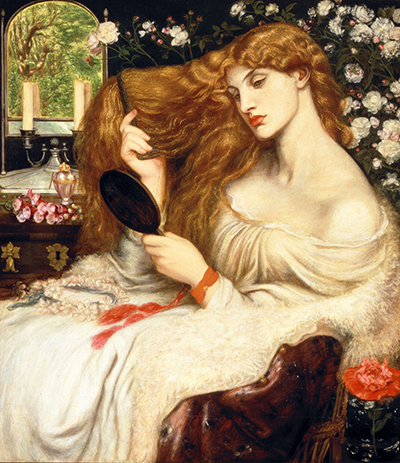The painting depicts Lady Lilith, who according to Judaic myth, was Adam’s first wife and a symbol of power, seduction, and temptation, as illustrated in this painting. He uses a reasonably young model, Alexa Wilding to figuratively display Lilith's acclaimed beauty, boldface, and self-absorbed attitude.
She sits looking at a mirror while brushing her long, beautiful hair which takes up most of the painting oblivious to voyeur of any kind. Rossetti, first painted Lady Lilith in 1866-1868 using Fanny Cornforth. However, in 1865 he met Alexa Wilding, who according to Rossetti brought out all the characteristic features of Lady Lilith. Rossetti described Alice’s beauty as more refined and able to express both virtue and vice evocative of the actual subject-Lady Lilith. Her red auburn hair, soft, dreamy eyes, long neck, and Cupid-bow lips fit Rossetti’s profile of his subject perfectly.
Style
Rossetti was a founding member of the Pre-Raphaelite Brotherhood remembered for their interest in specific types of women. Most of their pieces showcased women with angular facial features, a straight nose, a prominent jawline, voluminous hair as depicted on this painting. Unlike the Victorian prototypes which often looking like china dolls, their subjects were strong, grotesque, and statuesque. Rossetti’s pieces particularly stood out as his subjects were dominant, quite relentless, impassive and tall.
All these traits are embodied through Alexa's posture and physical characteristics. Her fixation on the hand-mirror demonstrates Lilith's attentiveness to her beauty which she uses to lure and dominate men. Rossetti also includes white roses in the background admiring Lilith’s beauty to symbolize the subject's, cold sensuous love. Viewers are also drawn to the red poppy on the right corner to denote sleep and forgetfulness; figurative of Lilith's languid personality.
Inspiration
Dante Rossetti created this painting after a commissioning by Fredrick Richards Leyland in early 1866. Rossetti had just met Alexa Wilding the previous year and had proposed to model for his paintings. Alice did not show up for the first appointment but later agreed to model for a weekly fee of £1.
Related Works
Sibylla Palmifera - Rossetti created this painting before in the later 1865 before persuading George Rae to commission it. He completed it in 1870 though, in 1869, Leyland had paid £200 for a copy that Rossetti never completed. Gabriel showcases a model holding a palm in her hands, symbolic of the spiritual nature of the painting. This time he uses red roses and poppies figurative of flower symbolism.




